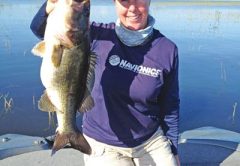In recent months CAM Okeechobee has presented a series of articles discussing the various aquatic plant zones within Lake Okeechobee. The series would not be complete without a discussion on algae. Though algae are classified under the plant kingdom they technically are not plants, they are quite simply a class of the own. Algae range in size from microscopic to meters in length and from single-celled to complex organisms that resemble seaweed kelps. They are an essential component of the ecosystem and a primary component of the food web, a major producer of oxygen, and a consumer of nitrogen. However as mankind’s influence over the planet has increased, the delicate balance between good and toxic algae has shifted to the point where the U.S. Environmental Protection Agency (EPA) declared it as one of America’s most widespread, costly and challenging environmental problems.
Healthy lakes need algae. Algae use sunlight to produce oxygen and carbohydrates that are eaten by protozoa and zooplankton which in turn are eaten by invertebrates and small fish which are then eaten by amphibians, birds, and bigger fish. Within a healthy lake there are hundreds of strains of algae and the bio-diversity within the biomass is dependent on a variety of conditions including light, temperature, pH, nutrient ratios, and currents.
In the case of Lake Okeechobee, after decades of mismanagement, bad practices and the encroachment by man, the balance of nutrients within the lake has shifted to a point of nutrient overload or ‘nutrient pollution’ resulting in frequent and sometimes large algae outbreaks commonly referred to as ‘blooms.’
With a diverse variety of algae strains within the lake, not all blooms are toxic to fish or humans. For these non-toxic blooms, the main concern is the thick matt of an algae bloom, or a high concentration of algae within the water column, will prevent sunlight from reaching the lake’s bottom thus starving bottom dwelling plants of light. Without light these plants will die-off and turn from a producer of oxygen to a consumer of oxygen which under extreme cases can result in fish kills.
For a few particular strains of algae when they die-off they can produce toxins which can be harmful to fish, animals, and in some cases even humans. These algae are commonly refer to as blue-green algae for they take on a blue-green color when they decompose. Blue-green algae is really not an algae but a photosynthetic bacteria within the Cyanobacteria family of organisms. When in full bloom, like other large matts of algae, they can strip oxygen from the water resulting in fish kills. In addition to consuming oxygen when they die, certain strains of decomposing blue-green algae will produce neural and hepato toxins such as mycrocystin that affect the nervous and respiratory systems and liver of fish and animals. Small domestic animals such as dogs and cats are susceptible to these toxins as well as general livestock and wildlife. Though algae toxins can accumulate in fish muscle tissue in small amounts, the highest concentrations will be found in the skin, fat, and internal organs of the fish. For healthy adults, consumption of fish from an affected area is generally discouraged and should be avoided by pregnant women, young children, older adults, and those with medical issues. During and immediately after a bloom, the consumption of clams and mussels must be avoided and only the meat portion of crayfish can be consumed, no heads, organs or juices. If ingested, mycrocystin can cause nausea, diarrhea and vomiting. In large amounts or in immune suppressed individuals, it may cause liver failure and even death.
So what’s causing these blooms and how can we stop them? Simply put, the chemical balance within the lake needs to be restored. Unfortunately there is no quick and easy solution to the problem. The Lake Okeechobee watershed covers over 4,785 square miles and extends north beyond Orlando. Of the two most harmful nutrients entering the lake today, nitrogen and phosphorous, 81% of the phosphorous comes from north of the lake. Phosphorous is a key component in the feed used in the diary, cattle and livestock industry as well as a byproduct of urban activities and is transported into the watershed via storm water runoff. Nitrogen on the other hand is used in fertilizers for the production of sugar cane, sod and vegetables.
Unfortunately simply reducing the loading of these nutrients into the lake will not be sufficient for the recovery of the lake. The real problem is the decade’s long build-up of these nutrients in the lake’s sediment. Recent studies suggest that the lake holds an estimated 270 million cubic yards of phosphorus rich mud containing more than 33,000 tons of phosphorus and that even with the reduction of external phosphorus loading, i.e. cleaning storm water runoff, the lake could take 20 to 30 years to clear itself of this pollutant.
In recent years, after the hurricanes of 2004 and subsequent increases in lake levels, algae blooms on the lake have become more common place. In addition, the discharge of this nutrient rich water into the canals that lead to the coastal estuaries has exasperated the problem to the point where action to resolve the issue has become mandated through environmental law, the courts, and public pressure. Considering the vast size of the watershed, the complexity of the issue, the various land use requirements within the watershed and the various government agencies, the restoration of Lake Okeechobee and those impacted downstream of the lake will take hundreds of millions of dollars and years to accomplish. Fortunately the Florida Department of Environmental Protection (DEP), our legislature, the Fish and Wildlife Conservation Commission (FWC), the Department of Health, the South Florida Water Management District (SFWMD), and the U.S. Army Corps of Engineers (US COE) are working together to address this complex environmental and public health issue.
For the near term the State’s response appears to be similar to treating a trauma patient, stabilize the situation and create no further harm. In this regard the SFWMD has aggressively pursued a program of diverting incoming storm water before it enters the lake as well as diverting water from the lake during periods of high water levels to minimize fresh water releases into the canals feeding the coastal estuaries. In creating these Storm Water Storage Areas (STA), polluted water is redirected and stored during Florida’s rainy season, filtered and cleaned of harmful nutrients by local vegetation, and then released back into the watershed as needed during the dry months. In addition to the building of STAs, as part of the Everglades Restoration program the Kissimmee River channelization project is being reversed and portions of the river returned to its former meandering ways. By returning the river to its natural flow, new wetland areas are being created that will help filter out nutrients from the river as well as slow the pace of nutrient loading into the lake during periods of heavy rains.
The benefits of these initial steps will first be seen in the coastal estuaries and the near shore and littoral areas of the lake. With water diverted and held during the rainy season, the estuaries should see a more consistent and cleaner flow of water and a return of the critical salinity balance needed for seagrasses and shellfish beds. Within the lake, the bulk of the phosphate rich sediment resides in the pelagic, deeper open water, areas of the lake. In the shallow marshes, the diversity of emergent and submergent plant life will help in the stabilization of sediments, the uptake the phosphorus, and the reduction in particulates and solubles within the water. All of which is great news for the local bass, forage fish, and other wildlife populations. Naturally these changes are not going to occur overnight but nor did the problem happen overnight.
THE FINAL STAGE IN THE RESTORATION OF THE LAKE WILL BE THE REDUCTION OF NUTRIENTS WITHIN THE LAKE’S SEDIMENT. GIVEN TIME THIS WILL OCCUR NATURALLY THOUGH PROBABLY NOT TO ANYONE’S PREFERRED TIME
The final stage in the restoration of the lake will be the reduction of nutrients within the lake’s sediment. Given time this will occur naturally though probably not to anyone’s preferred time schedule. Presently the various agencies are researching ways to reduce the levels of phosphorus in the mud but as we mentioned earlier, the most critical issue is to do no further harm to the environment. As science and technologies advance, solutions will present themselves. Until then we can do our part in the effort to restore Lake Okeechobee’s watershed by supporting legislative initiatives to fund the research and projects required for restoration as well as to keep pressure on our local, state, and federal representatives to keep this critical project moving forward.








